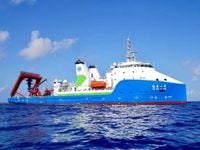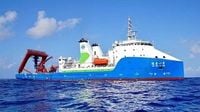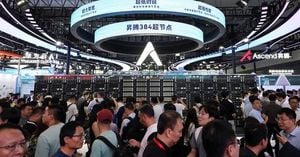On March 31, 2025, tensions between Australia and China intensified as a Chinese research vessel, the Tan Suo Yi Hao, was spotted off the South Australian coast, raising alarms about its potential dual purpose as a spy ship. This development coincided with Beijing's call for Australia to strengthen ties with China despite ongoing geopolitical frictions fueled by U.S. policies.
The Tan Suo Yi Hao, officially a scientific research vessel, was navigating within Australia’s exclusive economic zone and is believed to be tracking a deep-sea submarine communication cable. This ship, measuring 94 meters in length and equipped with advanced laboratories, has the capability to deploy a mini-submarine that can dive to depths of 10,000 meters. Its presence has sparked concerns that it may be mapping Australia’s underwater infrastructure, a critical component of the nation’s communication systems.
Prime Minister Anthony Albanese addressed the situation during a press conference, stating, "I would prefer that it wasn't there. But we live in circumstances where, just as Australia has vessels in the South China Sea and vessels in the Taiwan Strait and a range of areas, this vessel is there." He emphasized the importance of safeguarding Australia's national interests and expressed confidence in the capabilities of the Australian Defence Force (ADF) and security agencies.
As the national security debate heats up, Labor confirmed that authorities have been monitoring the Chinese vessel, which has been labeled a “spy ship” by various defense analysts. This scrutiny comes just four days into the Australian election campaign, where national security is expected to be a pivotal issue.
Michael Shoebridge, a defense expert and founder of the think tank Strategic Analysis Australia, criticized Australia’s military preparedness to monitor such vessels. He stated, "We lack the right kind of capabilities to monitor the ship and utilize its presence off the coast as an intelligence collection opportunity." Shoebridge pointed out that without sufficient aerial and undersea drones, Australia is missing a crucial chance to gather intelligence while the Tan Suo Yi Hao collects data that could benefit the People's Liberation Army (PLA).
Sky News reported that this vessel's movements closely resemble those of a Chinese warship that conducted live-fire exercises in the Tasman Sea just a month prior. The Tan Suo Yi Hao had recently participated in a joint exploration exercise with New Zealand before making its way around the Australian coastline, raising concerns about its intentions.
Former Home Affairs Department head Michael Pezzullo echoed these sentiments, suggesting that the ship's activities could enable the PLA Navy to plan submarine operations more effectively. He noted, "All such research is made available to the PLA, and is probably shaped by PLA research priorities."
The Tan Suo Yi Hao is not the first Chinese vessel to raise eyebrows in Australian waters. Its dual-use nature—servicing scientific research while potentially gathering intelligence—makes it a focal point of concern. Shoebridge explained, "The Chinese don't make a distinction between their civilian and military research like this, so this vessel got the capability to examine undersea cables, and it probably did that as it passed between New Zealand and Australia."
In the backdrop of these developments, Beijing's top local diplomat has urged Australia to collaborate with China despite the ongoing tariff war instigated by former U.S. President Donald Trump. This diplomatic overture comes as Australia grapples with the implications of China's increasing assertiveness in the region.
Experts warn that the presence of the Tan Suo Yi Hao could signal a broader strategy by China to enhance its maritime capabilities and assert its influence in the Indo-Pacific region. As Australia navigates this complex geopolitical landscape, the government's response to the Chinese vessel will be closely scrutinized.
With the election campaign underway, national security is likely to be a critical issue for voters. The ability of the ADF to respond to such maritime incursions will be a key topic of discussion among political leaders. Albanese's comments reflect the balancing act required in addressing national security while maintaining diplomatic relations with China.
As the situation unfolds, Australia finds itself at a crossroads, needing to bolster its defense capabilities while managing its diplomatic ties with a rising global power. The implications of the Tan Suo Yi Hao’s presence extend beyond immediate national security concerns, potentially influencing Australia's long-term strategic posture in the region.
In summary, the sighting of the Tan Suo Yi Hao off South Australia has illuminated vulnerabilities in Australia’s defense strategy and raised questions about the nation’s readiness to address foreign maritime activities. As the government grapples with these challenges, the upcoming election will likely reflect public sentiment on national security and Australia’s role in the evolving geopolitical landscape.








